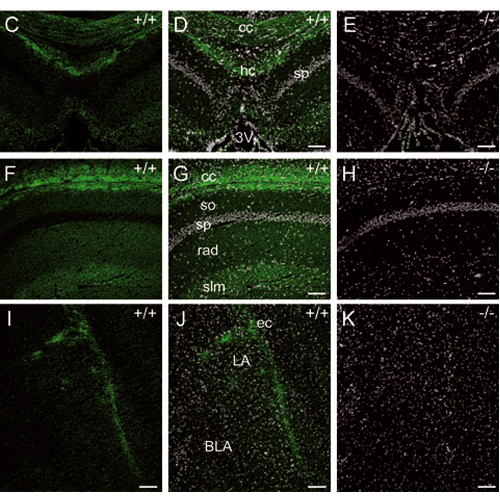Altered synaptic plasticity and behavioral abnormalities in CNGA3-deficient mice
24-Aug-2010
Genes, Brain and Behavior, 2010, doi:10.1111/j.1601-183X.2010.00646.x, published on 24.08.2010
Genes, Brain and Behavior, online article
Genes, Brain and Behavior, online article
The role of the cyclic nucleotide-gated (CNG) channel CNGA3 is well established in cone photoreceptors and guanylyl cyclase-D-expressing olfactory neurons. To assess a potential function of CNGA3 in the mouse amygdala and hippocampus, we examined synaptic plasticity and performed a comparative analysis of spatial learning, fear conditioning and step-down avoidance in wild-type mice and CNGA3 null mutants (CNGA3(-/-) ). CNGA3(-/-) mice showed normal basal synaptic transmission in the amygdala and the hippocampus. However, cornu Ammonis (CA1) hippocampal long-term potentiation (LTP) induced by a strong tetanus was significantly enhanced in CNGA3(-/-) mice as compared with their wild-type littermates. Unlike in the hippocampus, LTP was not significantly altered in the amygdala of CNGA3(-/-) mice. Enhanced hippocampal LTP did not coincide with changes in hippocampus-dependent learning, as both wild-type and mutant mice showed a similar performance in water maze tasks and contextual fear conditioning, except for a trend toward higher step-down latencies in a passive avoidance task. In contrast, CNGA3(-/-) mice showed markedly reduced freezing to the conditioned tone in the amygdala-dependent cued fear conditioning task. In conclusion, our study adds a new entry on the list of physiological functions of the CNGA3 channel. Despite the dissociation between physiological and behavioral parameters, our data describe a so far unrecognized role of CNGA3 in modulation of hippocampal plasticity and amygdala-dependent fear memory.











